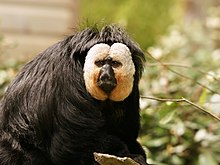Pitheciidae
| Pitheciidae[1] | |
|---|---|

| |
| White-faced saki (Pithecia pithecia) | |

| |
| Black-fronted titi (Callicebus nigrifrons) | |
| Scientific classification | |
| Domain: | Eukaryota |
| Kingdom: | Animalia |
| Phylum: | Chordata |
| Class: | Mammalia |
| Order: | Primates |
| Suborder: | Haplorhini |
| Infraorder: | Simiiformes |
| Parvorder: | Platyrrhini |
| Family: | Pitheciidae Mivart, 1865 |
| Type genus | |
| Pithecia Desmarest, 1804
| |
| Genera (extant) | |
The Pitheciidae (/pɪ
Characteristics
[edit]Pitheciids are small to medium-sized monkeys, ranging from 23 cm in head-body length for the smaller titis, to 44–49 cm for the uakaris. They have medium to long fur, in a wide range of colors, often with contrasting patches, especially on the face.
They are diurnal and arboreal animals, found in tropical forests from low-lying swamp to mountain slopes. They are predominantly herbivorous, eating mostly fruit and seeds, although some species will also eat a small number of insects. Sakis and uakaris have a diastema between the canine and premolar teeth, but the titis, which have unusually small canines for New World monkeys, do not.[2] All species have the dental formula: 2.1.3.32.1.3.3
Females give birth to a single young after a gestation period of between four and six months, depending on species. The uakaris and bearded sakis are polygamous, living in groups of 8-30 individuals. Each group has multiple males, which establish a dominance hierarchy amongst themselves. The titis and Pithecia sakis, by contrast, are monogamous and live in much smaller family groups.[2]
Classification
[edit]There are 54 currently recognized extant species of pitheciid monkey, grouped into two subfamilies and six genera.[1][3] Eleven extinct genera known from the fossil record are placed in the family, extending the age of the family to the Miocene.[4][5]
- Family Pitheciidae: titis, sakis and uakaris
- Subfamily Callicebinae, titis
- Genus Plecturocebus
- White-eared titi, Plecturocebus donacophilus
- Rio Beni titi, Plecturocebus modestus
- Rio Mayo titi, Plecturocebus oenanthe
- Ollala brothers's titi, Plecturocebus olallae
- White-coated titi, Plecturocebus pallescens
- Urubamba brown titi, Plecturocebus urubambensis
- Baptista Lake titi, Plecturocebus baptista
- Prince Bernhard's titi, Plecturocebus bernhardi
- Brown titi, Plecturocebus brunneus
- Parecis titi, Plecturocebus parecis
- Ashy black titi, Plecturocebus cinerascens
- Hoffmanns's titi, Plecturocebus hoffmannsi
- Red-bellied titi, Plecturocebus moloch
- Vieira's titi, Plecturocebus vieirai
- Milton's titi, Plecturocebus miltoni
- Chestnut-bellied titi, Plecturocebus caligatus
- Coppery titi, Plecturocebus cupreus
- Toppin's titi, Plecturocebus toppini
- Madidi titi, Plecturocebus aureipalatii
- Caquetá titi, Plecturocebus caquetensis
- White-tailed titi, Plecturocebus discolor
- Hershkovitz's titi, Plecturocebus dubius
- Ornate titi, Plecturocebus ornatus
- Stephen Nash's titi, Plecturocebus stephennashi
- Alta Floresta titi, Plecturocebus grovesi
- Genus Callicebus
- Barbara Brown's titi, Callicebus barbarabrownae
- Coimbra Filho's titi, Callicebus coimbrai
- Coastal black-handed titi, Callicebus melanochir
- Black-fronted titi, Callicebus nigrifrons
- Atlantic titi, Callicebus personatus
- Genus †Miocallicebus
- Genus Cheracebus
- Lucifer titi, Cheracebus lucifer
- Black titi, Cheracebus lugens
- Colombian black-handed titi, Cheracebus medemi
- Red-headed titi, Cheracebus regulus
- Collared titi, Cheracebus torquatus
- Genus †Carlocebus
- Genus †Homunculus
- Genus Plecturocebus
- Subfamily Pitheciinae
- Genus Cacajao, uakaris
- Black-headed uakari, Cacajao melanocephalus
- Bald uakari, Cacajao calvus
- Aracá uakari, Cacajao ayresii[3]
- Neblina uakari, Cacajao hosomi[3]
- Genus †Cebupithecia
- †Cebupithecia sarmientoi
- Genus Chiropotes, bearded sakis
- Black bearded saki, Chiropotes satanas
- Red-backed bearded saki, Chiropotes chiropotes
- Brown-backed bearded saki, Chiropotes israelita
- Uta Hick's bearded saki, Chiropotes utahickae
- White-nosed saki, Chiropotes albinasus
- Genus †Nuciruptor
- †Nuciruptor rubricae
- Genus †Mazzonicebus
- †Mazzonicebus almendrae
- Genus Pithecia, sakis
- Equatorial saki, Pithecia aequatorialis
- White-footed saki or buffy saki, Pithecia albicans
- Cazuza's saki, Pithecia cazuzai
- Golden-faced saki, Pithecia chrysocephala
- Hairy saki, Pithecia hirsuta
- Burnished saki, Pithecia inusta
- Rio Tapajós saki or Gray's bald-faced saki, Pithecia irrorata
- Isabel's saki, Pithecia isabela
- Monk saki, Pithecia monachus
- Miller's saki, Pithecia milleri
- Mittermeier's Tapajós saki, Pithecia mittermeieri (disputed)[6]
- Napo saki, Pithecia napensis
- Pissinatti's saki, Pithecia pissinattii (disputed)[6]
- White-faced saki, Pithecia pithecia
- Rylands' bald-faced saki, Pithecia rylandsi (disputed)[6]
- Vanzolini's bald-faced saki, Pithecia vanzolinii
- Genus †Proteropithecia
- †Proteropithecia neuquenensis
- Genus †Soriacebus
- †Soriacebus ameghinorum
- †Soriacebus adrianae
- †Genus Xenothrix
- †Jamaican monkey, Xenothrix mcgregori
- †Genus Antillothrix
- †Hispaniolan monkey, Antillothrix bernensis
- †Genus Insulacebus
- †Insulacebus toussentiana
- Genus Cacajao, uakaris
- Subfamily Callicebinae, titis
*Newly described species.[3] †Extinct taxa.
Silvestro etal 2017 showed the relationship among the extinct and extant pitheciid genera:[5]
| stem Pitheciidae |
| ||||||||||||||||||||||||||||||||||||||||||||||||||||||||||||||||||||||||||||||||||||||||||||||||
References
[edit]- ^ a b Groves, C. P. (2005). Wilson, D. E.; Reeder, D. M. (eds.). Mammal Species of the World: A Taxonomic and Geographic Reference (3rd ed.). Baltimore: Johns Hopkins University Press. pp. 141–148. ISBN 0-801-88221-4. OCLC 62265494.
- ^ a b Macdonald, D., ed. (1984). The Encyclopedia of Mammals. New York: Facts on File. pp. 358–361. ISBN 0-87196-871-1.
- ^ a b c d Boubli, J. P.; M. N. F. Da Silva; M. V. Amado; T. Hrbek; F. B. Pontual; I. P. Farias (2008). "A Taxonomic Reassessment of Cacajao melanocephalus Humboldt (1811), with the Description of Two New Species". International Journal of Primatology. 29 (3): 723–741. doi:10.1007/s10764-008-9248-7. S2CID 26561719.
- ^ The Paleobiology Database Pitheciidae entry accessed on 6 April 2010
- ^ a b Silvestro, Daniele; Tejedor, Marcelo F.; Serrano Serrano, Martha L.; Loiseau, Oriane; Rossier, Victor; Rolland, Jonathan; Zizka, Alexander; Antonelli, Alexandre; Salamin, Nicolas (2017). "Evolutionary history of New World monkeys revealed by molecular and fossil data". bioRxiv 10.1101/178111.
- ^ a b c Serrano-Villavicencio, J.E.; Murtado, C.M.; Vendramel, R.L.; Oliveira do Nascimento, F. (January 2019). "Reconsidering the taxonomy of the Pithecia irrorata species group (Primates: Pitheciidae)". Journal of Mammalogy. 100 (1): 130–141. doi:10.1093/jmammal/gyy167.




